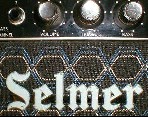 Amps
Amps Amps
Amps
BY TIM FLETCHER
.jpg)
Selmer Truvoice advertisement from January 1959.
Think you've never heard a Selmer ? Well, if you're
familiar with the immortal guitar riff forming the mainstay of The
Animals' "House of the Rising Sun" then you probably have. During the
course of an internet debate amongst Vox fans about what guitar
& amp was used to record the song, Hilton
Valentine (lead guitarist, whose fingers &
Gretsch Tennessean supplied the input signal) was finally tracked down
by e-mail and blew away conventional wisdom by declaring "No, it
definitely wasn't an AC30, I think it was a Selmer" ! As The Animals
were a Selmer-equipped band before that song catapulted them on to
fame, fortune and free Vox amps (with which they mimed it on TV), the
evidence suggests that he's right.
But that just illustrates how, in 60's Merrie England, Vox had all the
glory and Selmer took second place, leaving poor old Watkins (aka WEM)
to trail in third. Selmer started selling amps for the UK market before
Vox ever did. They looked good. They sounded good. They probably lacked
a little in street-cred because rebel rock'n'rollers may not have
wanted amps made by the same company who made the clarinets in the
school band. But principally they lacked two things, (1) The Shadows
and (2) The Beatles, as high-profile users. Sad, because both those
groups initially used Selmers, but abandoned them for Vox on the point
of finding fame - maybe they preferred Vox, or maybe Vox were just
smarter at giving free gear to the next set of pop icons. Either way,
the rich & famous bands used Vox, and the rest had to be
content with the cheaper Selmers & Watkins. (Like our host
Steve Russell!)
(Update...... Alex Turner of "The Arctic
Monkeys" uses a croc-skin Selmer Zodiac 30 as one of his main amps these days.
Selmer amplifiers seem to be making a major come-back at last!)
So who were Selmer, and why did they make guitar amps ? Click
HERE and this will take
you to a page which provides as much of the history of the Selmer
Company in the UK as we have been able to compile to date. As far as
the amps were concerned though, Selmer UK saw the rise of the guitar,
which came with the acoustic skiffle craze in 1956, as an opportunity. They were
also acting as UK distributors for Hofner guitars in particular, plus one or two
other brands. By then many of the guitars had pick-ups, and
Selmer faced the problem of supplying amplifiers to accompany them.
There was a post-war embargo on US imports at that time and a dearth of
manufacturers in Europe. As it happens, Selmer had taken over a small
company called RSA in December 1947, and this company had been
producing a range of PA amplifiers since 1946 under the RSA and Selmer
names. It was therefore easy to expand the RSA production into guitar
amplification in the mid 1950's with the introduction of such models as
the early RSA (non-Selmer) Truvoice Model TV19. The TV19
(Auditorium/Stadium) and TV6 (Popular) model designations on early
Selmer Truvoice amps was a throwback from that era. Later they seem to
have entered into production arrangements with other companies, in
particular Fenton-Weill because that company also made amps
near-identical to Selmer models under their own name. If you see an
"FW" stamp on your Selmer's circuit board then it was probably made by
Fenton-Weill. (Henry Weill was an early partner of Jim Burns in
Burns-Weill guitars, who went his own way to make guitars, amplifiers
and later lighting & disco products under the Fenton-Weill
brand, the Fenton part being taken from the name of a Burns-Weill
guitar model.
.jpg)
Selmer advertisement from March 1965.